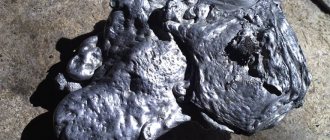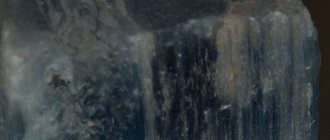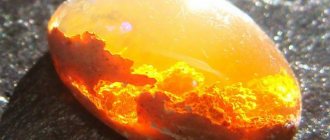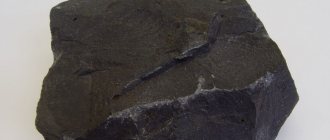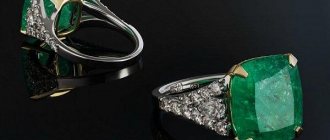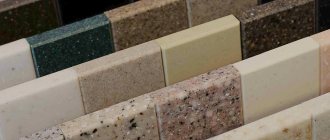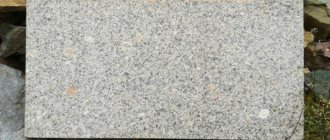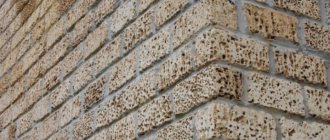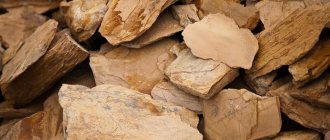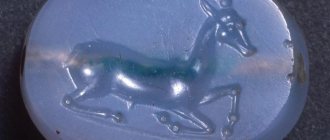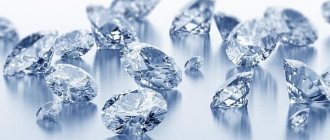Copper minerals and their formulas
Synonyms: Thin mixtures of native copper and cuprite were called cuprocuprite (Vernadsky, 1910).
Whitneyite—whitneyite (Ghent, 1859) and darwinite (Forbes, 1860)—arsenic copper that forms mixtures with algodonite. The Latin name for copper, cuprum, comes from the name of the island of Cyprus, from where copper was imported in ancient times. The origin of the Russian name is unclear.
The English name for the mineral Copper is Copper.
Copper nugget
- Chemical composition
- Varieties
- Crystallographic characteristics
- Form of being in nature
- Physical properties
- Chemical properties. Other properties
- Diagnostic signs. Satellites.
- Origin of the mineral
- Place of Birth
- Practical use
- Physical research methods
- Crystal optical properties in thin preparations (sections)
- Buy
Natural minerals containing copper
Native copper is rarely found in nature. Much more often it is part of various minerals. Only a few of them are of industrial importance:
- chalcocite;
- bornite;
- chalcopyrite
Chalcocite is also found in Eurasia - in the Northern Urals, Kazakhstan, Spain, Germany - and in America - the USA, Chile. Bornite is found both in porphyry (igneous) rocks and in the zone of secondary sulfide enrichment. Found in deposits of Europe, America, Africa. However, the main mineral of copper is considered to be chalcopyrite. It contains up to 80% Cu. Present in all types of ores. It was even found in lunar soil.
Other, less common, but used in industrial production, minerals:
- cuprite;
- azurite;
- malachite;
- brochantite;
- chrysotile.
Most of them accompany each other and are adjacent to the fields.
Chemical composition
Sometimes it contains impurities of Fe, Ag, Pb, Au, Hg, Bi, Sb, V, Ge 3 (silver copper with 3-4% Ag, ferrous copper - 2.5% Fe and golden copper - 2-3% Au). Impurities are observed more often in primary native copper; Recycled copper is usually purer. Composition of native copper from the Shamlug deposit (Armenia): Cu - 97.20 -97.46%, Fe - 0.25%; 98.3% Cu or more was determined in copper from Altai deposits.
Crystallographic characteristics
Syngony. Cubic.
Class. Hexoctahedral.
Crystal structure
The crystal structure is characterized by a face-centered lattice; Copper atoms are located at the corners and in the centers of the faces of the elementary cube. This is a formal expression of the fact that in the structure of copper there is a close packing (the so-called cubic close packing) of metal atoms with a radius of 1.27 A and a distance between nearest atoms of 2.54 A with a space fulfillment of 74.05%. Each Cu atom is surrounded by 12 similar ones (coordination number 12), located around it at the vertices of the so-called Archimedean cuboctahedron.
Main forms : a (100), d (110), o (111), l (530), e (210), h (410).
Copper at home
Isolation of this metal from ores saturated with it is therefore a relatively simple matter technologically. Some are therefore interested in how to mine copper at home. It will, however, be very difficult to obtain this metal from ore, clay, etc. with your own hands, without special equipment.
Some, for example, are interested in how to extract copper from clay with their own hands. Indeed, in nature there are deposits of this material, which is also rich in Cu. However, unfortunately, there are no known proven technologies for producing copper from clay at home.
You can try to isolate this metal with your own hands at home, perhaps only from copper sulfate. To do this, the latter must first be dissolved in water. Next, you should simply place some iron object into the resulting mixture. After some time, the latter - as a result of the substitution reaction - will be covered with a copper coating, which can then simply be cleaned off.
Source
Form of being in nature
The appearance of crystals . The shape of the crystals is cubic, tetrahexahedral, dodecahedral, less often octahedral (possibly pseudomorphs of cuprite). The edges are often rough, with depressions or elevations. Simple crystals are rare.
Doubles.
Intergrowth twins along (111) are common, sometimes polysynthetic, often lamellar in the direction of the twin axis or elongated parallel to the diagonal twins of the plane. Typically, crystals (simple and twins) are unevenly developed: elongated, shortened or deformed. Characteristic are dendritic forms, which represent uniform accretion of many crystals (uniformly deformed or regular) in any one direction. These are, for example, twin (111) crystals, elongated along the 2nd order symmetry axis and accreted parallel to the faces of the rhombic dodecahedron) or intergrowths of regular twin crystals, branching in the direction of the edges and diagonals of octahedral faces, as well as parallel intergrowths of crystals elongated in the direction 4th order axes. In continuous deposits of native copper during etching, signs of collective crystallization are revealed with the development of large grains at the expense of smaller zonal grains of irregular shape.
Aggregates. Distorted crystals, in single irregular grains, dendrite-like intergrowths, thread-like, wire-like, mossy formations, thin plates, concretions, powdery accumulations and solid masses weighing up to several hundred tons.
Dendrites
Mineral extraction methods
In Russia there are deposits such as shale and sandstone. Copper pyrite, copper-nickel and porphyry copper forms occur here. The mining industry uses various methods to extract minerals from the depths of the earth.
Depending on the depth of occurrence, ore is mined using open or closed methods. There are standards that determine the feasibility of the depth of excavation of soil layers and the use of technologies that reduce their costs.
The work technology includes the following:
- use of self-propelled equipment;
- production of ore extraction directly;
- filling the resulting voids with materials to make further work safe.
With the open method, fossils are selected in layers, this ensures their fullest use. For deep quarries, the technology of cyclic-flow operations is suitable, it depends on the characteristics of the layers.
Negative consequences of mining
When the formations occur at a depth of 500 to 1000 m and deeper, the closed method of copper mining is convenient. This requires vibration mechanisms; the rock is completely excavated and delivered to the surface. The voids formed underground are filled using pipes lined with rubber or basalt resin.
It is economically advantageous to locate the mineral processing industry in close proximity to the places of their extraction. It is also necessary to build plants for recycling waste after processing. This can promote the release of various beneficial products. For example, processing sulfur dioxide makes it possible to obtain useful fertilizers containing sulfur.
Physical properties
Optical
The color of a fresh fracture is light pink, quickly turning into copper-red, then brown; often with yellow or mottled tarnish.
The streak is copper-red, shiny.
Transparency. Opaque. In the thinnest plates it shines through in green.
Mechanical
The fracture is splintered and hooked.
Chemical properties
Easily dissolves in dilute HNO 3 and aqua regia, in H 2 SO 4 - when heated, in HCl - with difficulty. Ammonia dissolves in an aqueous solution, turning it blue. In polished sections it is etched with all the main reagents. The internal structure is easily revealed using NH 4 OH + H 2 O 2 or HCl + CrO 3 (50% solution).
Other properties
Very malleable and viscous. Electrical conductivity is very high; is significantly reduced by impurities.
Heating behavior. Pure copper melts at 1083°. Thermal conductivity is slightly less than that of silver.
Artificial production of the mineral.
It can be easily obtained from melts or by electrolysis from solutions of copper salts.
Diagnostic signs
Similar minerals
Recognized by the red color of the fresh surface, shiny streak, medium hardness and malleability, usually covered with greenish, black, blue deposits of oxidized copper minerals. Under a microscope in reflected light, it is easily determined by color and reflectivity.
Associated minerals. Cuprous gold, chalcocite, calcite, diopside, apatite, sphene, magnetite, malachite, barite, quartz, chalcopyrite.
Processing the resulting ore
As of today, there are 3 ways to process the resulting copper ore. Pyrometallurgical, hydrometallurgical and electrolysis.
The pyrometallurgical method is the most popular. The most common chalcopyrite is taken as the “working material”.
At the very beginning, enrichment is performed. For this purpose, the oxidative firing method is used. This method is very suitable for chalcopyrite, since it is primarily designed for ores with high sulfur concentrations. With this technology, the ore is heated to high temperatures (sometimes up to 8 thousand degrees Celsius), during which sulfur and oxygen interact, after which almost half of the sulfur evaporates. Next, the ore is heated even more in shaft or reverberatory furnaces. We are already talking about 1.4-1.5 thousand degrees.
Sometimes fake jewelry is made from copper, as a similar-colored material. To avoid counterfeits, be aware that copper darkens over time, and a metallic smell remains in the water.
The output, after exposure to such temperatures, is an alloy of copper and iron sulfides - matte. The alloy is blown through convectors, due to which both iron and sulfur are oxidized once again, evaporating in some places and settling as slag in others. The product becomes 91% blister copper.
In order to achieve almost standard copper content in the alloy, fire refining technology is used. An acidified solution of CuSO4 is also used with it. After these manipulations, which, by the way, are called electrolytic refining of copper, we get “pure” copper, with a concentration of 99.9%.
Origin and location
Hydrothermal. Accumulates in placers. Nuggets weighing up to 450 tons are described as unique phenomena.
Native copper is formed under reducing conditions during various geological processes; a significant part of it is released from hydrothermal solutions. Occurs as microscopic deposits in many, predominantly mafic, igneous rocks exposed to hydrothermal solutions, such as serpentinized peridotites, dunites and serpentinites. In this case, the appearance of native copper may be associated with the decomposition of previously formed copper sulfides, for example, cubanite (Urals, Transcaucasia). A similar origin can be attributed to native copper in amphibolitized basic rocks of the Serov region of the Sverdlovsk region. In the Karabash copper gold deposit of the Chelyabinsk region, native copper is observed in vein-like bodies of diopside-garnet rocks occurring among serpentinites; native copper here is characterized by an association with cuprous gold, chalcocite, calcite, diopside, apatite, sphene, magnetite, etc. In some ancient volcanic rocks (melafyres, diabases, etc.), metamorphosed under the influence of vapors, gases and hydrothermal solutions, copper performs tonsils, forms cement between the minerals of altered lava, fills voids and cracks; accompanied by hydrothermal minerals: analcime, laumontite, prehnite, datolite, adularia, chlorite, epidote, pumpelyite, quartz, calcite. The largest deposits of this type are located on the Keweenaw Peninsula in the Lake Superior region (Michigan, USA), where mineralization is confined to the Upper Proterozoic strata. The bulk of copper is mined from melafires and conglomerates, but the largest copper deposits (up to 400 tons or more) are found in calcite veins containing native silver and domeicite.
Deposits on the world map
The largest ore reserves are located in Chile - 34% of the world's total. The USA and Peru each have 9% of fossil deposits. Eastern Siberia, the Urals and the Kola Peninsula account for 5% of the deposits.
The world's copper deposits are located on the African continent, South America, Canada, and Australia. Of the European countries, Poland is the richest in them. There are known deposits in China and Mongolia.
Porphyry and vein deposits are located in the Western Pacific belt and Mediterranean regions. Kazakhstan, Armenia, and Uzbekistan have them.
Map of copper deposits in the world
Place of Birth
Segregations of native copper were observed in the diabases of Novaya Zemlya, in the traps of the Siberian Platform, among the main effusive rocks in Italy, on the Faroe Islands (Denmark), in Nova Scotia (Canada) and in other places. Representatives of rare types of hypogene deposits of native copper are the Franklin zinc-manganese deposit (New Jersey, USA) and the Longbahn and Jacobsberg manganese deposits (Sweden). Apparently, native copper deposits weighing up to several tons from the previously developed Kalmaktas deposit in Kazakhstan, represented in museums by excellent examples, are hypogenic. In the oxidation zone, especially in its lower parts, native copper is mainly an early alteration product of sulfide copper minerals, mainly chalcocite. It consists mainly of irregularly shaped deposits, less often - crystals and dendrite-like aggregates. Most often, native copper is accompanied by chalcocite, cuprite, calcite, and limonite. It is observed in a number of deposits in Kazakhstan (Dzhezkazgan, Berkara, Uspenskoye, etc.), Rudny Altai (Belousovskoye, Zyryanovskoye, Chudak, Talovskoye, etc.), the USA (Bisbee and Clifton-Morenci in Arizona, Tintik in Utah, etc.) . Part of the native copper in the oxidation zone arises by deposition from solutions containing copper sulfate. This is, for example, native copper, which forms segregations in cavities among limonite aggregates, sometimes in association with cuprite (Mednorudyanekoe deposit in the Sverdlovsk region, etc.). Pseudomorphoses of native copper are known, formed in the oxidation zone of chalcocite, cuprite, antlerite, chalcanthite, azurite, calcite, aragonite and other minerals. Particularly beautiful samples of native copper (crystals and dendritic intergrowths) come from the Turinsky mines of the Sverdlovsk region. In some mine workings, so-called cement copper is released from copper-containing waters on iron objects in the form of films and crusts. There are also cases of copper formation on half-rotten remains of fastening wood. In increased quantities, native copper is observed in some sedimentary rocks (sandstones, clays, marls) containing plant remains, in the form of irregularly shaped secretions, sometimes in pseudomorphs on wood or in the form of nodules. These are, for example, the Permian copper sandstones of certain regions of Russia (Ural region, Tatarstan, etc.), the Naukat sandstones in Kyrgyzstan, and the Cretaceous copper sandstones of Korokoro and Kobritsos in Bolivia, etc. The formation of native copper in some peatlands, for example, in the Sverdlovsk region, is also associated with reduction processes. region - along the Levikha River in the Tagila River basin and in the Sysert region. In the form of pebbles and grains, native copper is found in Russia in some placers: in the Urals, along the Yenisei, along the Bolshaya Sarkhoi River in Buryatia, along the Chorokh River in Georgia, on the Commander Islands and other places. In the state of Connecticut (USA), native copper was found in glacial sediments in the form of segregations weighing up to 75 kg. Small, irregularly shaped deposits of native copper were noted in the native iron of the Vengerovo meteorite in association with troilite.
Copper ore deposits
Copper ores are a collection of minerals that, in addition to copper, contain other elements that shape their properties, in particular nickel. The copper ore category includes those types of ores that contain such an amount of this metal that it is economically feasible to extract it by industrial methods. These conditions are satisfied by ores whose copper content is in the range of 0.5–1%. Our planet has a reserve of copper-containing resources, the bulk of which (90%) are copper-nickel ores.
Most of the copper ore reserves in Russia are located in Eastern Siberia, on the Kola Peninsula, in the Ural region. Chile is on the list of leaders in total reserves of such ores; deposits are also being developed in the following countries: the USA (porphyry ores), Kazakhstan, Zambia, Poland, Canada, Armenia, Zaire, Peru (porphyry ores), Congo, Uzbekistan. Experts have calculated that large copper deposits in all countries contain a total of about 680 million tons. Naturally, the question of how copper is mined in different countries must be considered separately.
Covellin
All copper ore deposits are divided into several categories, differing in genetic and industrial-geological characteristics:
- stratiform group represented by copper shales and sandstones;
- pyrite ores, which include native and vein copper;
- hydrothermal, including ores called porphyry copper;
- igneous, which are represented by the most common ores of the copper-nickel type;
- skarn type ores;
- carbonate, represented by ores of the iron-copper and carbonatite type.
In Russia, copper mining is carried out mainly in shale and sand deposits, in which the ore is contained in copper pyrite, copper-nickel and porphyry copper forms.
Bornite
Copper. Chemistry of copper and its compounds
Position in the periodic table of chemical elements
Copper is located in group 11 (or in a secondary subgroup of group II in short-period PSCE) and in the fourth period of the periodic table of chemical elements D.I. Mendeleev.
Electronic structure of copper
Electronic configuration of copper in the ground state :
+29Cu 1s 2 2s 2 2p 6 3s 2 3p 6 3d 10 4s 1 1s
2s 2p
3s
3p 4s 3d
In the copper atom, already in the ground energy state, an electron fails (leaks) from the 4s sublevel to the 3d sublevel.
Physical properties
Copper
– solid metal of golden-pink color (pink color in the absence of an oxide film). Copper is relatively easy to machine. It is found in nature, including in its pure form, and is widely used in various branches of science, technology and production.
Image from the portal zen.yandex.com/media/id/5d426107ae56cc00ad977411/uralskaia-boginia-liubvi-5d6bcceda660d700b075a12d
Melting point 1083.4 o C, boiling point 2567 o C, copper density 8.92 g/cm 3 .
Copper is a valuable metal in the recycling industry. By handing over copper scrap to a collection point, you can receive a good monetary reward. Read more about accepting copper scrap.
Being in nature
Copper
found in the earth's crust (0.0047-0.0055 wt.%), in river and sea water. In nature, copper occurs both in compounds and in native form. The industry uses chalcopyrite CuFeS2, also known as copper pyrite, chalcocite Cu2S and bornite Cu5FeS4. Other copper minerals are also common: covellite CuS, cuprite Cu2O, azurite Cu3(CO3)2(OH)2, malachite Cu2 (OH) 2 CO 3. Sometimes copper is found in native form, the mass of which can reach 400 tons.
Methods for obtaining copper
Copper is obtained from copper ores and minerals. The main methods for obtaining copper are electrolysis, pyrometallurgical and hydrometallurgical.
- Hydrometallurgical method: dissolution of copper minerals in dilute solutions of sulfuric acid, followed by displacement by metallic iron.
For example , displacement of copper from sulfate by iron:
CuSO4 + Fe = Cu + FeSO4
- Pyrometallurgical method : obtaining copper from sulfide ores. This is a complex process that includes a large number of reactions. Main stages of the process:
2CuS + 3O2 = 2CuO + 2SO2
2) reduction of copper from the oxide, for example, with hydrogen:
CuO + H2 = Cu + H2O
- Electrolysis of solutions of copper salts:
Qualitative reactions to copper (II) ions
Qualitative reaction to copper ions +2 - interaction of copper (II) salts with alkalis . This produces a blue precipitate of copper(II) hydroxide .
For example , copper(II) sulfate reacts with sodium hydroxide :
Copper(II) salts color the flame green.
Chemical properties of copper
In compounds, copper can exhibit oxidation states +1 and +2.
1. Copper is a chemically low-active metal. When heated, copper can react with some non-metals: oxygen, sulfur, halogens.
1.1. When heated, copper reacts with fairly strong oxidizing agents, for example , oxygen , forming CuO, Cu2O, depending on the conditions:
2Cu + O2 → 2CuO
1.2. Copper reacts with sulfur to form copper(II) sulfide :
1.3. Copper interacts with
halogens .
In this case, copper (II) halides are formed: 2Cu + I2 = 2CuI
1.4. With nitrogen, carbon and silicon copper
does not react:
Cu + N2 ≠
Cu + C ≠
Cu + Si ≠
1.5. Copper does not interact with hydrogen.
1.6. Copper reacts with oxygen to form an oxide :
2Cu + O2 → 2CuO
2. Copper also interacts with complex substances:
2.1. Copper in dry air and at room temperature does not oxidize, but in humid air, in the presence of carbon monoxide (IV), it becomes covered with a green coating of hydroxycopper carbonate (II):
2.2. In the voltage series, copper is located to the right of hydrogen and therefore cannot displace hydrogen from solutions of mineral acids (dilute sulfuric acid, etc.).
For example , copper does not react with dilute sulfuric acid :
2.3. In this case, copper reacts when heated with concentrated sulfuric acid . When heated, the reaction proceeds, sulfur (IV) oxide , copper (II) sulfate and water :
2.4. Copper reacts even under ordinary conditions with nitric acid .
With concentrated nitric acid:
With dilute nitric acid:
Reaction of copper with nitric acid
2.5. Alkali solutions have practically no effect on copper.
2.6. Copper displaces metals to the right in the voltage series from solutions of their salts .
For example , copper reacts with mercury(II) nitrate to form copper(II) nitrate and mercury:
Hg(NO 3 ) 2 + Cu = Cu(NO 3 ) 2 + Hg
2.7. Copper is oxidized by nitrogen oxide (IV) and iron salts (III)
Areas of use
Copper is in greatest demand in electrical engineering. Due to its low electrical resistance, it is actively used for the manufacture of wires, cables, conductive elements of transformers, and electric motor windings are made from it. More than half of all mined copper is consumed by the industry.
The metal has good strength and ductility, which makes it suitable for the manufacture of products of complex shapes: household items, jewelry; for creating seamless pipes. Copper pipes are often used in equipment and various engineering systems to organize heat exchange. The properties of copper such as low coefficient of thermal expansion and high thermal conductivity are used here.
Copper alloys are widely used:
- bronze - a compound with tin, the name is also used for alloys of copper with other metals, such as aluminum, lead, silicon, beryllium and others;
- brass - with zinc;
- cupronickel, nickel silver, manganin - with nickel;
Copper is also included as one of the components in other compounds, for example, in duralumin. Jewelers often use copper alloys with the addition of gold.
